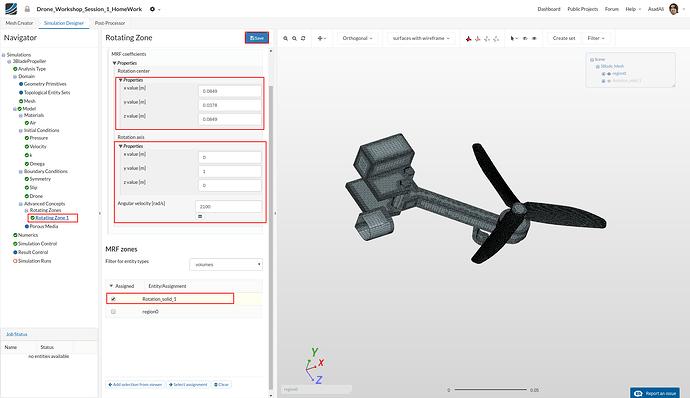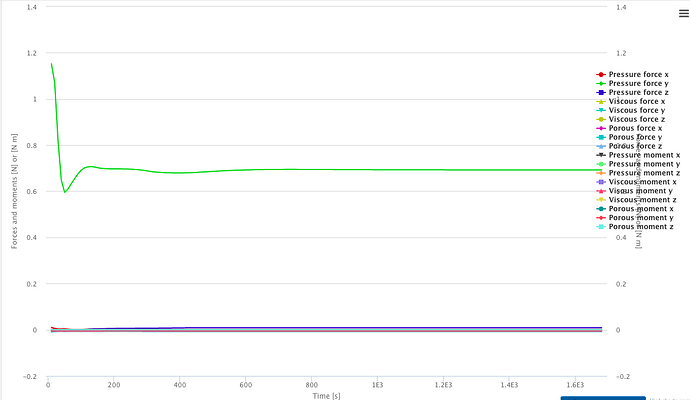How are the rotational speeds changed as asked at the beginning of the article?
Hi @jmayger!
As depicted in the picture below you simply have to change the angular velocity of the rotating zone.
Cheers,
Jousef
Oh right Cheers!
Sorry for the continued questions but how would I be able to see the results of the lift created?
Hi @jmayger and sorry for the delayed answer!
You can see the pressure force in y-direction in the post-processing which corresponds to the lift you were looking for. Hope that clears things up a bit and feel free to contact me whenever you have any questions, no need to worry about “too many questions” - that’s why we have the forum 
Enjoy your week!
Jousef
During the video it says that the graph correlates to the simulation error so I wasn’t sure.
This is the graph I have, would this be a correct representation of the lift force as I have to find and interpret results for a school project.
If this is a graph of Lift Force how would you describe it in relation of drone movement as the graph progresses in time?
Thanks Heaps!
Hi @jmayger!
Both statements are correct. You usually (or often) use the force plots to see if forces converge during the simulation. In this case stopping the simulation let’s say at 50 seconds or 100 seconds won’t make much sense because the pressure force is still varying. Here we can say at approximately 400 seconds that the force has converged because it is not changing its value anymore - does that make sense to you?
Cheers!
Jousef
Yes thanks, So does that mean that to graph and/or table results I would select the value at around 400 Seconds as the overall Lift Force created by the propeller?
Thank you So much Jousef!
Hi! I set up the simulation and everything went well (after some trial and error of course!). I just wanted to know if there’s a way to measure the power required to spin the propeller at a given speed. I didn’t find any way to display it in the result control settings, so i guess i need to calculate the power by my own, maybe using a formula that relates the speed of the blades to the lift generated, but i’m just guessing. Thank you in advance!
Hi @jarnoldi
You can take a look at this video- https://www.coursera.org/lecture/3d-model-creation-fusion-360/-kok1O which can make this problem simpler and reduce the number of required calculations.
Thanks
Ani
Hello ani, thanks for the link; but what if the propeller was spun by a combustion-powered motor instead of an electric one? How do i know if the motor has enough power to spin the blade at a certain speed? Thank you
Hmmm…  before I answer that, I would like to ask that do you have dynamometer for measuring the power generated by your engine?? or have any rpm vs power curve of the Ic motor you are using??
before I answer that, I would like to ask that do you have dynamometer for measuring the power generated by your engine?? or have any rpm vs power curve of the Ic motor you are using??
Unfortunately, no (i know that combustion engines are very tricky compared to electric ones, where the torque is more constant as speed changes). However, i found a site which claims to give power and thrust if you insert some parameters http://godolloairport.hu/calc/strc_eng/index.htm and i found a formula on this site http://www.starlino.com/power2thrust.html
If I understand that question correctly, @jarnoldi wants to estimate power necessary to rotate propeller from simulation at different rates. AFAIK in simulation you have all pieces of geometry as a target for ‘Forces and Moments’. I suggest you add new ‘Forces and Moments’ checkpoint, selecting only ONE blade. Then you will be getting additional information about drag or viscous drag for one blade. Lift will be of course also present.
From that point on, you should be able to estimate power necessary to move the propeller.
Explanation is simple: forces and moments cancels on the XZ plane (rotation is along Y axis), if measures are harvested from all blades together, some will be positive, some negative.
Thank you very much! So now i know the force (F) that is equal to the drag generated by the blade as you pointed out, but i will also need the speed…should i use the rotational speed of the blades (v) in the equation P=Fv? If so, should i use rad/s as the unit of measurment of v?
Rotational speed is expressed in rad/s.
Ok, i will let you know if i have any other questions, but at the moment i think i have all that i need. Thank you very much!
What am I missing, as long as the moment about the Y axis is given for ALL blades, then power needed to rotate prop at that rpm is a simple calculation from there…


